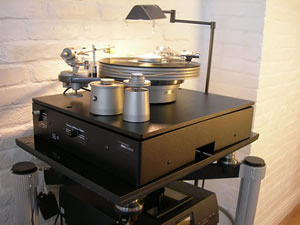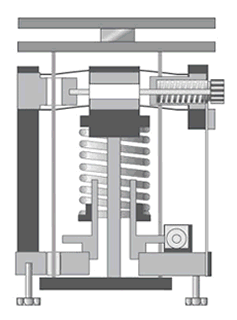
The Analog Department - September 2021
What's Under Your Turntable...!
Q: What holds your turntable?
A: Hopefully, it's not the top surface of a loudspeaker, or that you've got it on top of your receiver/amplifier......or any device that creates electro-magnetic fields, or vibrates when powered up.
The turntable is sensitive to its environment.
Here's what's at play:
In the groove it's a physical imprint of an acoustic waveform. The platter spins the record at (we hope) precisely 33-1/3rd rpm. The stylus traces the terrain of the groove, wiggling a cantilever about its pivot. If moving magnet - cantilever wiggles the magnet near to coils of wire. If moving coil - cantilever wiggles a criss-cross of coils within the magnetic field of a powerful magnet. Electro-magnetic induction produces a voltage in the same waveform of the groove modulations tracked.
This current is tiny. Measured in milli-volts (symbol: mV, 1 mV = .001 volts ) it can be as low as .13 mV for a low output moving coil, or from 2.5mV to7mV if moving magnet. Moving iron output is similar to moving magnet output. In whichever case it's a tiny signal generated through electro-magnetic induction - as the diamond stylus - too small to be seen without a microscope - traces a comparatively sized modulated groove.
Such a fragile and tiny electric signal can be corrupted by forces from within the turntable and by external airborne forces from without.* The signal can be dirtied with the noise of vibrations coming up through the platter and mat holding the Lp. The signal can be corrupted, even destroyed by airborne sound waves bombarding the phonograph cartridge from above. The induction signal generation going on in the cartridge can be corrupted by nearby electromagnetic fields. We want to make sure it's not one of the other audio components.
*(we might also look into tone arm wiring at this point, but the page is about turntable support, not wires.)
So the thing is sensitive to its environment.
The page means to explore the various methods, tools and products that can reduce these performance polluting processes as noted above through the use of turntable stands as well as special turntable footers that can mitigate or even eliminate surface borne vibration and help isolate from airborne sound waves.
Define and identify the forces at play.
Surface borne vibrations are generated by the turntable itself. Some designs of turntables have a platter drive process that generates more vibrations than do others. For instance idler driven turntables tend to produce higher levels of drive train vibrations than do belt drive or direct drive models. It is possible to mitigate this somewhat through plinth and cabinetry design. Methods of vibration dampening for idler driven turntables can be found elsewhere in pages devoted to plinth design. This page is about 'what's under' your turntable..
External surface borne vibrations flow into the turntable through the furniture that supports it. If the turntable sits atop an audio component rack holding several system components, the combined vibrations of all the components might be traveling up and down throughout the rack. Just a possibility one might think about.
Loud-speaker generated airborne sound waves can attack the stylus/groove interface from above in subtle or not-so-subtle ways.
Loud speaker generated sound waves can travel through solid materials to enter your turntable.
Seismic: a word that implies floor shaking or the Earth in motion.
Footfall: Webster's says it's the sound of a footstep. In audio, footfall is something more than just the sound of a footstep. Also implied is the impact a footstep has upon the floor in the room. Imagine you have your LP-12 up on top of a nice and not-inexpensive component rack playing a record. All might be well but with every step you take, the floor ripples under the load/impact of your foot. The seismic ripple flows through the flooring to your audio rack and shakes it. Up on top of the rack the effect is more like a teeter motion that tilts the rack this way and that in tiny sharp jerky motions. The turntable shakes. The stylus in the groove might even jump out of the groove from this violent disturbance. And it's a reality in modern home architecture. The suspended floor. Some buildings and houses have flexible flooring, others are more solid and less susceptible to the seismic ripple effects of footfall.
Ideally, the turntable needs be held absolutely motionless. Perfectly still. That's a fairly tall order since the ground upon which we build our homes is in constant motion. I read somewhere that the Earth itself vibrates at around 3 hz (cycles per second). All by itself! Then, in addition, if you live in the city and next to a street, the traffic going up and down your street can produce vibrations that flow through your home...and into your turntable. But that's life living next to traffic. Quieter ground can be found. Perhaps the building you are in and indeed the very land it stands upon will provide your turntable with the best of all upgrades...or it might provide it with additional challenges to be overcome.
Acoustic considerations, Room shape. Proximity to a speaker. Proximity to room corners. Room treatments.
Yes but this is about support hardware, some of which can mitigate the effects of acoustic feedback.
In every case, the turntable is sensitive to its environment.
Negative Stiffness: Minus-K

Minus K Technology BM-8 platform shown supporting a Simon York S7 turntable. This platform boasts passive 1/2 hz vertical and 1/2 hz horizontal vibration isolation. More information at: https://www.minusk.com/
It is worth noting that the Minus-K platforms seem to offer the best performance/price ratio. Sub-herz performance at a fraction of the cost of its competition.
Technology employed: Negative Stiffness


Applications: Industrial.
Microscopy (scanning electron microscopes, etc.)
Laser/Optical Systems
Biology/Neuroscience
Vacuum Isolation
Check it out: A custom order Minus-K for ken Fritz's very special, "no holds barred" turntable".
An Interview with Ken Fritz on Eliminating Vibration in High-End Audio Playback
Audiophile, Ken Fritz, talks about the critical nature of eliminating vibration in audio playback, and how technology solutions like Negative-Stiffness vibration isolation have enabled the exceptional performance of his latest, quite unique and much applauded, high-end home audio system.
by Jim McMahon
|